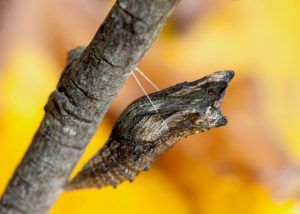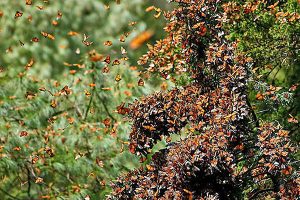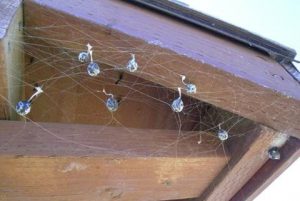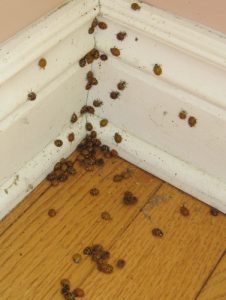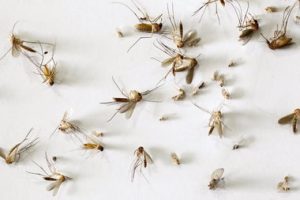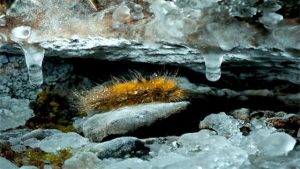While many people don’t look forward to the icy roads and shoveling snow that winter always brings, many are happy that all of the bugs have died for the year! Or have they really?
During the chilly months of winter, not many creatures tend to stir. Reptiles and amphibians hibernate, birds migrate, and mammals hunker down in their cozy caves. But what happens to all of the bugs?!
All bugs/insects/arachnids each have a way of ensuring the population continues when spring rolls around. If they all died off, there wouldn’t be generations of bugs to look forward to the following years. Some bugs are favorites, such as butterflies and bees, but some, such as spiders and stinkbugs, people say they could do without. It is important to remember that all creatures have a purpose for existing and are important in the ecosystem. However, sometimes it is nice to get a reprieve from certain bugs that would normally be sucking out blood – I’m looking at you mosquitoes!
– Butterflies/Moths – Many butterflies and moths will breed one last time before the winter season. They will lay their eggs and the caterpillars will either overwinter as larvae or will form their chrysalis/cocoon and overwinter in that state. The adults will then die off and the next spring the new generation of butterflies/moths will emerge from the chrysalises and the caterpillars will come out of hibernation and continue the life cycle. Examples of common butterflies/moths that do this are: Swallowtails, Fritillaries, Skippers, and Luna moths. Some butterflies will overwinter as adults, but in order to do that, they have to migrate! The greatest butterfly migration is that of the Monarch Butterfly. The 4th generation (those who emerge in the fall) will migrate thousands of miles to Mexico in order to overwinter in warmer climates. These Monarchs enter diapause (a state of rest) and will “wake up” in the spring to lay the next generation of eggs. This generation has the longest lifespan, but the most difficult as traveling can take a tole on the fragile body of a butterfly!
- Swallowtail Chrysalis Overwintering
- Monarch Butterfly Migration
-Honeybees – Many people believe that Honeybees hibernate. You never see them flying around in the winter, and of course there are no flowers for them to collect nectar from, so what else would they do?! Well, surprisingly, Honeybees stay awake and active all winter long. Honeybees make honey in order to eat throughout the winter when there are no flowers available. The bees have to be active in order to keep the honey from freezing! They stay awake and actively beat their wings to keep the section of the hive they are clustered in at a balmy 80+ degrees Fahrenheit! The colony during the winter is made up of all females! The girls chase the boys out of the hive before winter because the boys are not needed and would only consume the stored honey. The workers take care of the Queen and in the spring, the Queen will lay unfertilized eggs that will hatch into more boys for her to mate with.
- Winter Honeybee Hive – Infrared shows the location the bees are keeping warm.
-Spiders – Spiders are often found in houses during the winter as an un-welcomed visitor. This is one strategy for spiders to survive the winter – move where it is warmer! Spiders tend to enter household or hole up in garages during the winter to escape the brutal temperatures and snow. In the spring they tend to move back outside as there is more food available to them in the outdoors than in your bedroom! Some other species of spiders will overwinter in web casings that they build around them. And yet others will lay eggs in a protected sac, die, and let the next generation of babies continue on in the spring.
- Spider Egg Casings
-Ladybugs/Stinkbugs – These two insects tend to be in everyone’s houses during the winter. The main method of surviving the cold months is to more to slightly warmer and more protected areas. Fortunately or unfortunately, your house tends to be the coziest looking place for them to sneak into! If they cannot find a house to break into, they will find a different protected areas, such as a log or a small crack in a stone and go into diapause. In this resting state, they consume almost no energy as they don’t move much and do not eat. In the spring they come out of diapause to lay eggs and continue the cycle.
- Ladybugs Swarming a House
-Ticks/Mosquitoes – Ticks often remain active as long as temperatures are above freezing. When they dip below that, they enter a diapause state until they can emerge again. Mosquitoes actually hibernate. Adult females will find a small hole to overwinter in and wait for warmer weather. A few species will lay eggs and die.
- Dead Mosquitoes
-Woolly Bear Caterpillars – Technically a stage in the life cycle of the Isabella Tiger Moth, I separated this one from the moth section because these little guys do something amazing! When the weather begins to get cold, these caterpillars begin searching for a place to go into diapause. Normally, this is when most of them are seen as they scurry across the road or across the sidewalk to that perfect leaf pile. Once they find a location, they become very still. Their hemolymph (bug equivalent of blood) will actually begin to crystallize in their body! They become a little fuzzy ice cube until the spring thaws them out and they can continue on with their life cycle.
- Woolly Bear Freezing
Bugs, insects, and arachnids make up nearly 80% of the world’s species of living creatures. Therefore, it would take a while to tell you where each one goes for the winter! However, I hope the above has given you a glimpse into the lives of the bugs that many of us are all too familiar with!

